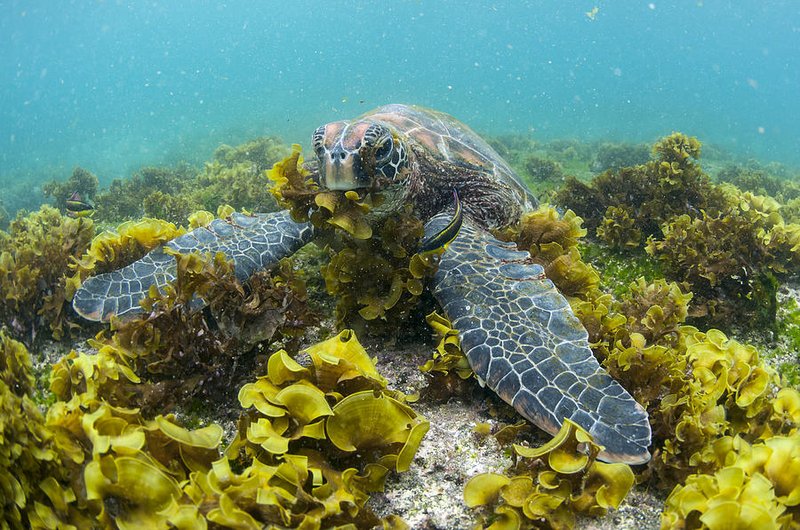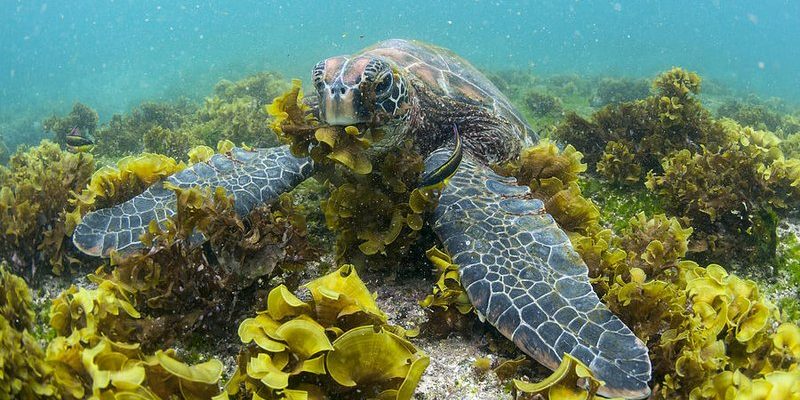
Let’s dive deeper into the world of the green sea turtle’s diet and feeding habits. You might be surprised to learn that they’re herbivores as adults, munching primarily on seagrasses and algae, which plays a vital role in maintaining healthy underwater habitats. Imagine a chef preparing a meal with fresh ingredients; for green sea turtles, the ocean is their kitchen filled with plenty of nutritious options.
The Basics of Green Sea Turtle Diet
Green sea turtles primarily dine on a salad of seagrasses and algae. They are classified as herbivores, making their feeding habits quite unique compared to other turtles. While the young turtles may consume small amounts of jellyfish and crustaceans, adult green sea turtles shift their focus almost entirely to plant matter.
They typically feed on various types of seagrasses, including turtle grass and manatee grass, and different types of algae. This plant-based diet allows them to be efficient foragers as they graze along the ocean floor. The green sea turtle’s diet not only sustains them but also contributes significantly to the health of their marine ecosystems. By eating seagrass, they help promote growth and maintain balance within their environment.
You might be wondering about their feeding techniques. Green sea turtles use their strong, serrated jaws to rip through the seagrass and algae. It’s like a lawnmower gliding over grass, ensuring they get the most nutrition possible. This grazing behavior creates a more balanced underwater habitat, making it easier for other marine life to thrive.
Feeding Behavior and Habitat
Where do green sea turtles like to eat? Typically, they prefer shallow coastal waters, which are rich in seagrass beds and algae. These areas can be found in warmer oceans, often around coral reefs or mangroves. Think of these spots as their favorite dining restaurants, filled with their go-to meals.
During feeding, green sea turtles can often be seen nibbling on seagrass meadows, which are crucial to the ecological health of coastal areas. The turtles’ feeding habits help maintain these environments by preventing the overgrowth of algae and promoting healthier seagrass beds. Healthy seagrass meadows benefit not just the turtles but the entire marine ecosystem, supporting various species of fish and other sea creatures.
Interestingly, green sea turtles are known for their migratory habits. They often travel long distances to find feeding grounds that offer abundant food sources. This is a bit like going on a road trip to discover new restaurants! During these migrations, they can adapt their diets based on the available food, which adds another layer of complexity to their feeding behavior.
How Diet Impacts Turtle Health
A green sea turtle’s diet directly affects its overall health and longevity. When these turtles consume a varied and nutritious diet, they can grow strong, reproduce successfully, and help maintain their ecosystems. Just like humans, when turtles eat well, they’re more resilient against diseases and predators.
However, poor dietary habits or a lack of available food sources can lead to problems. For instance, if seagrass meadows are damaged by pollution or coastal development, turtles may struggle to find their preferred meals. This can lead to malnutrition, which diminishes their immune system and makes them more vulnerable to illness.
One striking thing to note is that when turtles consume plastic debris mistaken for food, it can cause serious health issues, blocking their digestive tracts. This is a major concern for conservationists, as the impact of human activities on ocean health affects not only turtles but the entire marine food web.
Seasonal Changes in Diet
Interestingly, green sea turtles can alter their diets based on seasonal changes and the availability of food. For example, during certain times of the year, some areas might have an abundance of seagrasses, while other regions may be more sparse. Green sea turtles are smart foragers and can adapt their eating habits accordingly.
In warmer months, they might feast more on tender seagrass shoots, while in cooler months, they may rely more on algae. This dietary flexibility is essential for their survival and helps them thrive in varying environmental conditions.
Moreover, the seasonal cycles of their food sources also play a significant role in their migratory patterns. Turtles often follow the best feeding opportunities, which can lead them to travel long distances in search of their next meal. It’s like planning a seasonal menu based on what’s fresh and available!
Human Impact on Green Sea Turtle Diet
Sadly, human activity has a significant impact on the diet and feeding habits of green sea turtles. Coastal developments, pollution, and climate change all play a role in altering the natural habitats where these turtles feed.
For instance, when coastal areas are developed, the seagrass meadows that turtles rely on can be destroyed or polluted. Pollution, especially plastic waste, can also litter the oceans, making it dangerous for turtles who might mistake it for food. These issues pose severe risks, not just to the turtles but to the entire marine ecosystem.
Conservation efforts are crucial to protect the feeding grounds of green sea turtles. Initiatives aimed at reducing plastic waste, restoring seagrass habitats, and creating marine protected areas can help ensure that these turtles have access to their essential food sources.
Conservation and Preservation Efforts
So, what’s being done to protect green sea turtles and their diets? Conservation groups worldwide are working tirelessly to address the issues affecting these amazing creatures. Through education, awareness campaigns, and habitat restoration projects, they aim to secure a future for green sea turtles.
One effective approach is advocating for cleaner oceans and reducing plastic consumption. By raising awareness about the dangers of plastic waste, we can help prevent turtles from ingesting harmful materials. Additionally, community involvement in seagrass restoration projects can help replenish the vital habitats these turtles rely on for food.
It’s crucial for everyone to take part in conservation efforts. Whether it’s participating in local clean-up events or supporting organizations dedicated to marine life, individual actions can make a difference. By working together, we can help ensure that green sea turtles have a healthy diet and thriving ecosystems for generations to come.
The Importance of a Balanced Diet
Ultimately, the diet of the green sea turtle teaches us an important lesson about balance in nature. These turtles illustrate how interconnected life is in the oceans. Their feeding habits not only impact their health but also the health of entire ecosystems.
Just as we strive for a balanced diet to maintain our health, green sea turtles need access to a variety of nutritious food sources. Understanding their dietary needs helps us recognize the importance of protecting their habitats and the broader marine environment.
In conclusion, the diet and feeding habits of green sea turtles are a captivating topic that highlights not just their role in the ocean but our responsibility to protect their habitats. By being aware of the challenges they face and supporting conservation efforts, we can help ensure that these magnificent creatures continue to thrive in our oceans.

